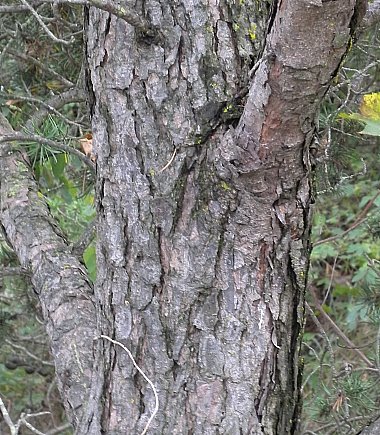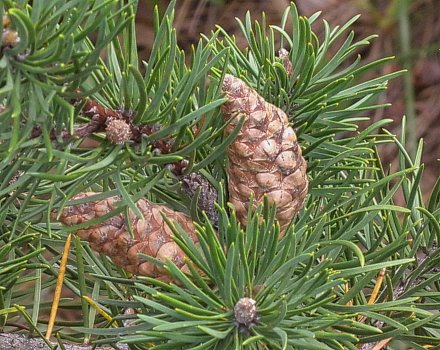Description: This coniferous tree is 30-70' tall at maturity. The growth and development of individual trees will depend on their situation. Trees growing in the open usually have a globoid-ovoid crown with a branching and crooked trunk, while trees growing in dense pine forests usually have a small oblongoid crown on top of a tall straight trunk. Branches within the crown are ascending-spreading to drooping; they are often crooked. Trunk bark is gray with reddish brown patches, somewhat scaly and flaky, and becoming slightly ridged with age. Bark of the branches is predominately gray or gray-brown and smooth to very flaky. Young branchlets are greenish yellow and smooth. The needle-like evergreen leaves are arranged on the branchlets in clusters of 2; they are pale green and ¾–1½" long. Each pair of leaves are divergent; individual leaves are slightly curved and twisted.

Jack Pine is monoecious with both male (pollen-bearing) and female (seed-bearing) cones on the same tree. These cones develop in small clusters near the tips of branchlets. The male cones are about ½" long and cylindrical in shape. After shedding their pollen, they soon wither away. The female cones are 1½–2" long at maturity, broadly lanceoloid in shape, and nearly sessile. These cones often turn slightly inward toward their tips. Initially, the female cones are mostly green, but they become brown at maturity during their 2nd year. The woody scales of the female cones are thickened toward their tips and without prickles (or they have very small vestigial prickles). The blooming period occurs during the spring or early summer for about 2 weeks. The cones are cross-pollinated by the wind. At the base of each scale of the female cones, there are 2 seeds that are winged and flattened. Individual seeds are 4-5 mm. long and their winged extensions are 10-12 mm. long. There are two types of female cones: Serotinous cones don't release their seeds until they have been exposed to the heat of a fire, while non-serotinous cones release their seeds immediately at maturity. If there is no fire, serotinous cones will release their seeds after a period of several years. The proportion of serotinous versus non-serotinous cones varies with the local ecotype. When the seeds are released, the female cones become globoid in shape, changing color from brown to gray. This tree reproduces by reseeding itself. Sometimes it forms dense colonies, particularly in the northern portion of its range.
Cultivation: Jack Pine prefers full sunlight, dry conditions, and an acidic mineral-rich soil that is sandy or rocky. Young trees start to produce cones after only 4-5 years. This tree is very winter-hardy. It is vulnerable to various disease organisms.

Range & Habitat: The native Jack Pine is found only in northern Illinois, where it is rare (see Distribution Map) and state-listed as 'endangered.' Illinois lies along the southern boundary of its distribution. Further to the north into Canada, this tree is common in some areas. In Illinois, habitats include sandy woodlands, sandy savannas, sand prairies, rocky sandstone cliffs, and stabilized sand dunes along Lake Michigan. This tree thrives in barren dry areas where there is a history of fire. While individual trees are only moderately resistant to fire, their seeds germinate in response to the heat and greater amounts of sunlight. Jack Pine is rarely used as a landscape tree.
Faunal Associations: Many insects feed on various parts of Jack Pine and other pines. This includes wood-boring larvae of long-horned beetles, larvae and adults of weevils, larvae of bark beetles, larvae of pitch midges (Cecidomyia spp.), plant bugs, stink bugs, aphids (mostly Cinara spp.), spittlebugs, armored scales, mealybugs, larvae of conifer sawflies (Diprionidae), larvae of web-spinning sawflies (Pamphiliidae), wood-boring larvae of horntail wasps (Siricidae), larvae of dagger-tail sawflies (Xyelidae), larvae of Geometer moths, larvae of owlet moths (Noctuidae), larvae of snout moths (Pyralidae), larvae of Tortrix moths, larvae of Sphinx moths (Lapara spp.), the Pinetree Spur-throated Grasshopper (Melanoplus punctulatus), and larvae of a butterfly, the Eastern Pine Elfin (Callophrys niphon). Insects that prefer Jack Pine as a host plant include the Jack Pine Aphid (Cinara banksiana), Jack Pine Budworm (Choristoneura pinus), Jack Pine Tip Moth (Rhyacionia granti), Yellow Jack Pine Tip Moth (Rhyacionia sonia), and Jack Pine Resin Midge (Cecidomyia resinicola). The Insect Table provides more complete information about insects that feed on pines.

Many bird species feed on the seeds of Jack Pine and other pine trees. Examples include the Red Crossbill, White-winged Crossbill, Pine Siskin, Pine Grosbeak, Black-capped Chickadee, Pine Warbler, and Red-breasted Nuthatch. The Bird Table provides a more complete list of these species. Some mammals also use pine trees as a source of food. The White-tailed Deer browses on the foliage and twigs during the winter and spring, while the Cottontail Rabbit occasionally eats young saplings. The North American Porcupine feeds on the bark and wood. Other mammals, such as the White-footed Mouse, Eastern Gray Squirrel, Fox Squirrel, and American Red Squirrel, eat the seeds (Martin et al., 1951/1961). The Silver-haired Bat (Lasionycteris noctivagans) and other species of bats sometimes use pine trees as roost sites by hanging from branches or by hiding in cavities and exfoliating bark (McGuire et al., 2012). An endangered bird that is found in Michigan, Kirtland's Warbler (Setophaga kirtlandii), locates its nests at the base of small specimens of Jack Pine in sandy savannas (Buech, 1980).
Photographic Location: A foredune along Lake Michigan at Indiana Dunes State Park in NW Indiana.
Comments: This small tree is distinguished by its short needle-like leaves (only ¾–1½" long) that are arranged in clusters of 2, and its persistent pine cones, which have incurving tips and lack significant prickles. Other Pinus spp. (Pines) in Illinois have longer leaves (exceeding 1½"); some species in this genus also have their leaves arranged in clusters of 3-5, while other species have cones with significant prickles. Jack Pine's irregular pattern of growth often provides it with a 'bonsai' appearance.